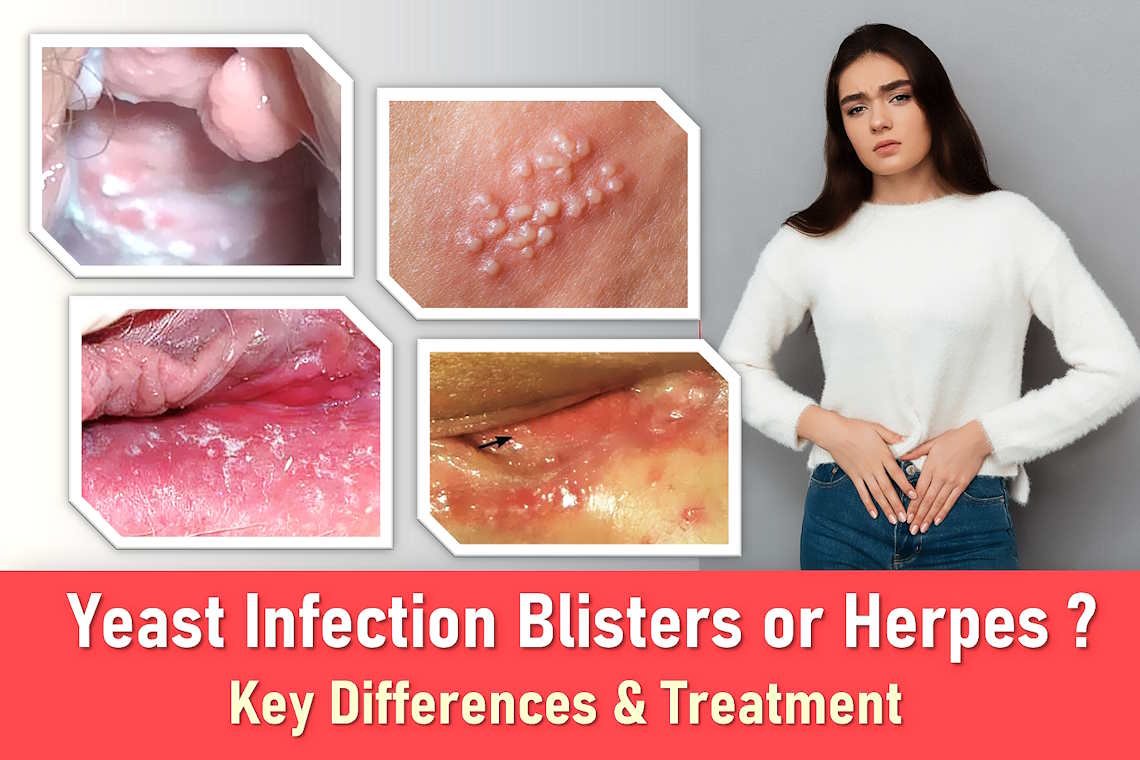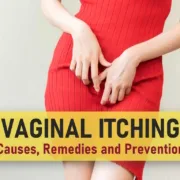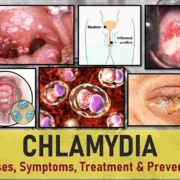Yeast Infection Blisters or Herpes? Key Differences & Treatment
Key Takeaways
- Different Causes: Herpes is a viral STI (HSV-1/HSV-2) while yeast infections are fungal (Candida overgrowth)
- Distinct Symptoms: Both cause itching, but herpes leads to blisters while yeast infections cause thick discharge
- Diagnosis Matters: 75% of women get yeast infections, but self-treatment can delay proper herpes diagnosis
- Effective Treatments: Antivirals for herpes, antifungals for yeast – but only with correct diagnosis
- When to Worry: See a doctor for blisters, recurrent symptoms (>4/year), or if OTC treatments fail
Why These Conditions Get Confused
That unbearable vaginal itching and discomfort could signal either a yeast infection or genital herpes – two very different conditions that surprisingly share similar initial symptoms. About 3 out of 4 women will experience a yeast infection in their lifetime, making it the go-to assumption when genital discomfort strikes. But what if it’s actually herpes?
The confusion arises because both conditions can cause:
- Persistent itching and irritation
- Pain during urination or sex
- Redness and swelling in the genital area
The Critical Differences That Matter
While the initial discomfort might feel similar, yeast infections and herpes progress very differently:
| Yeast Infection | Genital Herpes | |
|---|---|---|
| Primary Symptom | Thick, white discharge (like cottage cheese) | Small, painful blisters that crust over |
| Symptom Duration | 1-3 days with treatment | 1-2 weeks per outbreak |
| Transmission | Not sexually transmitted (pH imbalance) | Skin-to-skin sexual contact |
Why Proper Diagnosis Matters
Reaching for over-the-counter yeast treatments might seem logical, but misdiagnosis can lead to:
- Treatment resistance: Overusing antifungals makes future yeast infections harder to treat
- Disease progression: Untreated herpes outbreaks may become more severe
- Partner transmission: Unknowingly spreading HSV to sexual partners
- Missed diagnoses: Overlooking other conditions like BV or dermatological issues
This guide will help you understand the key differences between yeast infection blisters vs herpes, recognize telltale symptoms, and learn when professional diagnosis is essential.

Genital Herpes: Key Facts
Genital herpes is a sexually transmitted infection caused by the herpes simplex virus (HSV). There are two types:
- HSV-1: Typically causes oral herpes but can affect the genital area
- HSV-2: More commonly causes genital herpes
How Herpes is Diagnosed
Healthcare providers use several methods to diagnose herpes:
- Clinical diagnosis: For recurrent outbreaks with characteristic symptoms
- Blood test: Identifies HSV antibodies
- PCR test: Detects HSV genetic material from a swab of affected area
Note: Standard STI panels don’t always include herpes testing – you may need to specifically request it.
For more information please see “Genital Herpes: Symptoms, Pictures, and Medication“.
Yeast Infections: What You Need to Know
A vaginal yeast infection occurs when there’s an overgrowth of Candida, a type of fungus naturally present in the vagina. While small amounts are normal, excessive growth leads to symptoms.
Diagnosing Yeast Infections
Medical professionals typically diagnose yeast infections through:
- Microscopic examination of vaginal discharge
- PCR tests for yeast detection (most accurate)
- Assessment of symptoms and medical history
For more details please see “Vaginal Yeast Infections: Symptoms, Causes and Treatment”
Symptom Comparison: Herpes vs. Yeast Infection
While both conditions can cause genital discomfort, their symptoms differ significantly:
Genital Herpes Symptoms
Many people with herpes experience no symptoms or very mild ones. When symptoms do occur, they may include:
- Skin lesions that progress through stages (bumps → blisters → sores → scabs)
- Pain, burning, or itching in the genital area
- Pain during urination
- Flu-like symptoms (fever, headache, swollen glands)
The first outbreak is typically the most severe, with subsequent outbreaks being milder and shorter.
Yeast Infection Symptoms
Yeast infections typically cause:
- Intense vaginal and vulvar itching
- Redness and swelling
- Thick, white, odorless discharge (often compared to cottage cheese)
- Burning during urination or sex
Unlike herpes, yeast infections don’t typically cause fever, swollen glands, or visible blisters.
Key Differences Between Yeast Infection Sores vs. Herpes
Medical professionals differentiate these conditions by examining two main factors:
Medical History
Important questions include:
- What triggered the symptoms?
- How quickly did symptoms appear after potential exposure?
- How have symptoms progressed over time?
Visual Examination
Doctors look for:
- Appearance of any lesions or rash
- Location and distribution of symptoms
- Type of discharge (if present)
- Depth of skin affected
Progression of Symptoms: Yeast Infection Blisters vs. Herpes
While both conditions might start with itching, they progress very differently:
Yeast Infection Progression
- Itching intensifies and spreads across the entire vulvar area
- Redness and swelling develop
- Thick, white discharge becomes noticeable
- Symptoms typically resolve within 1-3 days with treatment
Herpes Progression
- Initial itching progresses to painful lesions
- Lesions evolve through distinct stages over several days
- Often accompanied by flu-like symptoms before outbreak
- Outbreaks typically last at least a week
- May experience swollen lymph nodes in groin area
Visual Differences: Yeast Infection Sores vs. Herpes Lesions
The appearance of symptoms provides important clues:
Herpes Lesions
- Begin as small red bumps
- Progress to fluid-filled blisters
- Blisters break open to form painful ulcers
- Eventually crust over and heal
- Typically clustered in one area
Yeast Infection Sores
- Generalized redness and swelling
- No true blisters (though severe cases may develop sores)
- Affects the entire vulvar/vaginal area
- White, thick discharge present
Discharge Differences
The type of discharge can help distinguish between conditions:
| Characteristic | Yeast Infection | Herpes |
|---|---|---|
| Amount | Abundant | Minimal |
| Color | White | Clear or slightly cloudy |
| Consistency | Thick, clumpy (like cottage cheese) | Watery |
| Duration | Persists throughout infection | Brief, only during blister stage |
Remember: If you’re experiencing abnormal discharge or odor, you’re more likely dealing with a vaginal infection like yeast rather than herpes.
For more information please see “Vaginal Discharge with Different STDs: Key Signs You Shouldn’t Ignore“.
Transmission: Herpes vs. Yeast Infection
Understanding how these conditions spread can help you assess your risk and take proper precautions.
How Herpes Spreads
Genital herpes transmits through:
- Skin-to-skin contact with infected area
- Contact with infected secretions during sex (vaginal, oral, or anal)
- Contact with oral herpes (cold sores) during oral sex
Important facts about herpes transmission:
- Many people spread the virus without knowing they’re infected
- Virus can spread even when no symptoms are present
- You can’t tell if someone has herpes by their appearance or sexual history
How Yeast Infections Develop
Unlike herpes, yeast infections aren’t sexually transmitted diseases. They occur when:
- The vaginal microbiome becomes imbalanced
- Candida (yeast) overgrows
Common triggers include:
- Antibiotic use
- Hormonal changes (birth control, pregnancy)
- Uncontrolled diabetes
- Tight clothing
- Chemical irritants (soaps, douches)
- Sex (can introduce new bacteria and change pH)
Treatment Options: Yeast Infection Sores vs. Herpes
Since these conditions have different causes (virus vs. fungus), they require completely different treatments.
Herpes Treatment Options
While there’s no cure for herpes, effective treatments can:
- Shorten outbreaks
- Reduce symptoms
- Lower transmission risk
Common antiviral medications include:
- Acyclovir
- Famciclovir (Famvir)
- Valacyclovir (Valtrex)
Treatment approaches:
- Episodic treatment: Taking medication during outbreaks
- Suppressive therapy: Daily medication to prevent outbreaks
Yeast Infection Treatment Options
Yeast infections are treated with antifungal medications:
- Over-the-counter options:
- Miconazole
- Clotrimazole
- Prescription treatments:
- Terconazole
- Fluconazole (oral medication)
Important notes about yeast infection treatment:
- See a doctor for proper diagnosis before self-treating
- Some yeast strains may be resistant to standard treatments
- Recurrent infections may require longer treatment courses
- Boric acid suppositories may help for resistant cases
Can You Have Sex With Herpes or Yeast Infection?
With herpes:
- Avoid sex during active outbreaks
- Use antiviral medication as prescribed
- Disclose status to partners
- Use protection to reduce transmission risk
With yeast infection:
- Best to avoid sex until treatment is complete
- Yeast can potentially spread to partners
- Male partners have about 15% chance of developing symptoms
- Female partners should watch for symptoms
Discussing Herpes With Partners
Telling someone you have herpes can feel daunting, but remember:
- Herpes is extremely common (1 in 5 women have HSV-2)
- Many people have herpes without knowing it
- With proper management, risk of transmission can be minimized
Options for notifying partners:
- Have a direct, honest conversation
- Use anonymous notification services if preferred
- Provide educational resources about herpes
Addressing Herpes Stigma
Despite being common, herpes carries unnecessary stigma because:
- Historical misconceptions about STIs
- Lack of public education
- Cultural attitudes about sexual health
Important facts to remember:
- About 600,000 new HSV-2 infections occur annually in the US
- Women are twice as likely as men to get genital herpes
- Black women face disproportionate stigma and infection rates
While herpes isn’t curable, it’s manageable with:
- Effective medications
- Healthy lifestyle choices
- Open communication with partners
Final Thoughts
Whether you’re dealing with yeast infection blisters or herpes symptoms:
- Seek proper medical diagnosis
- Follow recommended treatments
- Practice self-care and compassion
- Remember you’re not alone – these conditions affect millions
With accurate information and proper care, both conditions can be managed effectively, allowing you to maintain your sexual health and quality of life.
Frequently Asked Questions
Can herpes be mistaken for a yeast infection?
Yes, herpes can sometimes be confused with a yeast infection, especially in the early stages. Both conditions can cause vaginal itching and discomfort, but there are important differences:
- Yeast infections typically cause intense itching, redness, and thick white discharge resembling cottage cheese
- Genital herpes often begins with tingling or burning before painful blisters or sores appear
If you’re experiencing persistent or unusual symptoms, it’s important to see a healthcare provider for proper diagnosis and treatment.
What do yeast infection sores look like?
True sores from a yeast infection are rare and only occur in severe cases. When they do appear, they may include:
- Dry, cracked skin on the vulva
- Small fissures or breaks in the skin
- Red, irritated areas that may resemble mild herpes sores
Does herpes smell like a yeast infection?
Neither herpes nor yeast infections typically cause strong odors. If you notice:
- A strong or foul vaginal odor
- Fishy-smelling discharge
You may have bacterial vaginosis (BV) or another type of infection that requires different treatment.
Can a yeast infection cause bumps?
While yeast infections don’t typically cause distinct bumps like herpes blisters, some people may experience:
- Generalized vulvar redness and swelling
- Small raised areas from irritation
- Rash-like texture in severe cases
True bumps or blisters are more likely to indicate herpes or another condition.
How long do yeast infection symptoms last compared to herpes?
- Yeast infections: Typically improve within 1-3 days with proper treatment
- Herpes outbreaks: Usually last 1-2 weeks for the first outbreak, shorter for subsequent ones
Can men get symptoms from a partner’s yeast infection?
Yes, though it’s less common (about 15% of male partners develop symptoms), which may include:
- Redness, itching or burning on the penis
- Small red bumps or rash
- Discomfort during sex or urination
Are yeast infection pictures helpful for self-diagnosis?
While yeast infection pictures can provide general guidance, they have limitations:
- Many vaginal conditions look similar visually
- Symptoms can vary significantly between individuals
- Professional diagnosis is more reliable than comparing to pictures
Can you have both a yeast infection and herpes at the same time?
Yes, it’s possible to have both conditions simultaneously. This might occur because:
- Herpes outbreaks can disrupt the vaginal microbiome
- Antiviral medications might increase yeast infection risk
- The immune system is focused on fighting the viral infection
When should I see a doctor about possible yeast infection or herpes symptoms?
Seek medical attention if you experience:
- Symptoms that don’t improve with OTC treatments
- Severe pain or discomfort
- Recurrent episodes (more than 4 per year)
- Fever along with genital symptoms
- Uncertainty about your diagnosis
Can children get genital yeast infections or herpes?
While less common in children, both conditions can occur:
- Yeast infections may develop from antibiotics, diabetes, or poor hygiene
- Herpes in children requires immediate medical attention as it may indicate abuse
Any genital symptoms in children should be evaluated by a pediatrician.










